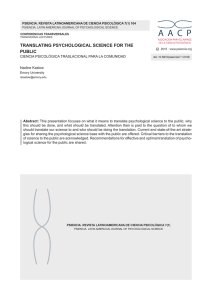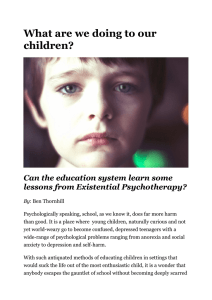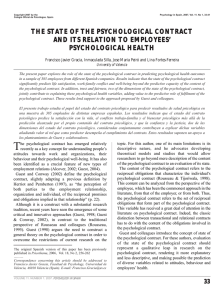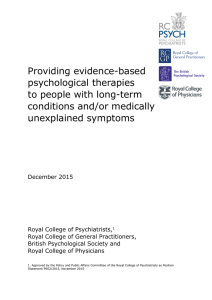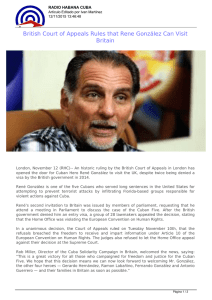English - International Journal of Psychology and
Anuncio
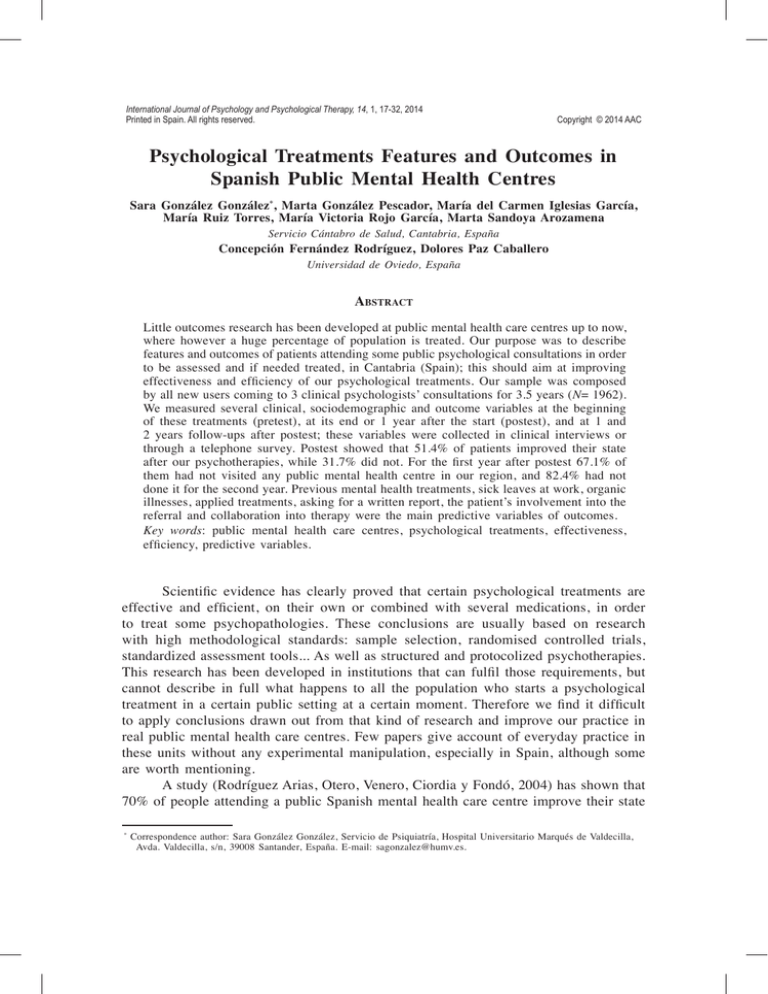
International Journal of Psychology and Psychological Therapy, 14, 1, 17-32, 2014 Printed in Spain. All rights reserved. Copyright © 2014 AAC Psychological Treatments Features and Outcomes in Spanish Public Mental Health Centres Sara González González*, Marta González Pescador, María del Carmen Iglesias García, María Ruiz Torres, María Victoria Rojo García, Marta Sandoya Arozamena Servicio Cántabro de Salud, Cantabria, España Concepción Fernández Rodríguez, Dolores Paz Caballero Universidad de Oviedo, España Abstract Little outcomes research has been developed at public mental health care centres up to now, where however a huge percentage of population is treated. Our purpose was to describe features and outcomes of patients attending some public psychological consultations in order to be assessed and if needed treated, in Cantabria (Spain); this should aim at improving effectiveness and efficiency of our psychological treatments. Our sample was composed by all new users coming to 3 clinical psychologists’ consultations for 3.5 years (N= 1962). We measured several clinical, sociodemographic and outcome variables at the beginning of these treatments (pretest), at its end or 1 year after the start (postest), and at 1 and 2 years follow-ups after postest; these variables were collected in clinical interviews or through a telephone survey. Postest showed that 51.4% of patients improved their state after our psychotherapies, while 31.7% did not. For the first year after postest 67.1% of them had not visited any public mental health centre in our region, and 82.4% had not done it for the second year. Previous mental health treatments, sick leaves at work, organic illnesses, applied treatments, asking for a written report, the patient’s involvement into the referral and collaboration into therapy were the main predictive variables of outcomes. Key words: public mental health care centres, psychological treatments, effectiveness, efficiency, predictive variables. Scientific evidence has clearly proved that certain psychological treatments are effective and efficient, on their own or combined with several medications, in order to treat some psychopathologies. These conclusions are usually based on research with high methodological standards: sample selection, randomised controlled trials, standardized assessment tools... As well as structured and protocolized psychotherapies. This research has been developed in institutions that can fulfil those requirements, but cannot describe in full what happens to all the population who starts a psychological treatment in a certain public setting at a certain moment. Therefore we find it difficult to apply conclusions drawn out from that kind of research and improve our practice in real public mental health care centres. Few papers give account of everyday practice in these units without any experimental manipulation, especially in Spain, although some are worth mentioning. A study (Rodríguez Arias, Otero, Venero, Ciordia y Fondó, 2004) has shown that 70% of people attending a public Spanish mental health care centre improve their state * Correspondence author: Sara González González, Servicio de Psiquiatría, Hospital Universitario Marqués de Valdecilla, Avda. Valdecilla, s/n, 39008 Santander, España. E-mail: [email protected]. 18 González, González, Iglesias, Ruiz, Rojo, Sandoya, Fernández, & Paz significantly one year after starting a psychotherapy. These authors have developed a procedure which can be used by any clinical psychologist in order to replicate their findings (Rodríguez Arias & Venero, 2006), upon which we have based our research. Besides, Labrador, Estupiñá and García Vera (2010) describe a 52.45% rate of patients who attended a public University psychotherapy centre and finished successfully. Introducing some experimental manipulation, Fernández Méndez et al. (2010, 2011) used real patients, diagnosed with any depressive, anxiety or adaptative disorders in several mental health care centres, who were randomly assigned either to a control group (psychological or psychiatric treatment as usual) or to an experimental group (brief integrative-eclectic psychotherapy). This second option resulted in better clinical and satisfaction outcomes until 2 years later, and it was shorter and therefore cheaper than the usual treatment. Other authors have also studied the effects of psychological treatments in public settings by choosing certain psychopathologies and/or psychotherapies (Beyebach et al., 2000; Echeburúa, Salaberría, de Corral, Cenea y Berasategui, 2000; García Palacios et al., 2002; Peñate, Pitti, Bethencourt, de la Fuente y Gracia, 2008). Spanish state health institutions provide psychological treatments to people who could need them, because of any mental health problem. These treatments are mainly applied by clinical psychologists in Mental Health Units (Unidades de Salud Mental -USM), and can also be combined with psychiatric treatment, the support of a nurse or a social worker and /or drugs prescribed by the general practitioner (GP). Otherwise people can be referred to a more specialized structure within our mental health services. Psychological treatments in USM are usually provided through fortnightly or monthly 30 minutes sessions, for as long as needed. Clinical psychologists are free to choose the psychotherapy they find more useful for each case, so no guidelines are defined. The aim of this paper is to describe the features, provided treatments, outcomes and their predictive variables of all real users who have come to several USM in Cantabria in order to be assessed and if needed treated by 3 clinical psychologists, during a period of time of 3.5 years. After knowing what is happening in this kind of settings we would like to improve our effectiveness and efficiency. We are clinical psychologists working in USM who wanted a research method to give us as many data as possible, but it should be simple and short, so that we could collect our variables without significantly altering our daily work, without any extra time or funding consuming. Method Participants Sample was made up of all outpatients coming to 3 clinical psychologists’ consultations in different USM for the first time, and/or because of a new health demand, for a certain time span between October 2006 and March 2010 (N= 1962). All users gave informed consent prior to their participation into the study. © International Journal of Psychology & Psychological Therapy, 2014, 14, 1 http://www. ijpsy. com Psychological Treatments in Spanish Public Mental Health Centres 19 Design and procedure We designed an ex post facto study in which each patient was assessed at four different moments: (1) at his first interview (pretest); (2) after his first interview when no more interviews were scheduled, after finishing or abandoning the psychological treatment when this happened, or after receiving it for a whole year if it lasted more than 1 year (postest); (3) 1 and 2 years after postest (1 and 2 years follow-ups). Not all the patients recruited at pretest have accomplished all the measurements (see n figures for each variable below). We decided to consider that the treatment was finished after 1 year and do postest then even if it really did keep on, because the main therapeutic changes are proved to be done within that time. At pretest, the psychologist recorded 17 sociodemographic and clinical predictive variables as they were reported by the patient at his first interview. Besides, the clinician recorded the diagnosis of his mental problem following the 10th International Classification of Diseases (ICD-10) diagnostic criteria, as well as its estimated severity applying the Severity scale of the Clinical Global Impressions (CGI-S) (Guy, 1976). In this scale the therapist answers one question about the intensity of the mental disease as he sees it, giving to it one of 7 possible degrees: 1 (normal, not at all mentally ill), 2 (borderline ill), 3 (mildly ill), 4 (moderately ill), 5 (markedly ill), 6 (severely ill), 7 (extremely ill). At postest the same clinicians recorded 11 predictive variables related to applied treatments, as well as 3 outcome variables: (1) result, observed by the therapist, qualifying it as success if he considers therapy goals were mainly achieved, or failure if he considers they were not achieved (besides this, no treatment provided, referrals to other centres and interruptions for other reasons were codified); therapists assessed at the same time whether it had been the patient who had stopped attending the therapy (abandonment), or the psychologist or the patient had decided its interruption (discharge), or it had not finished after 1 year; (2) the Improvement scale of the Clinical Global Impressions (CGI-I), answered by the therapist; (3) the CGI-I, answered by the patient (when possible). This scale rates the change produced after treatment through 7 degrees: 1 (much better), 2 (quite better), 3 (some better), 4 (the same, no change), 5 (some worse), 6 (quite worse), 7 (much worse). At 1 year follow-up clinicians only collected a variable reporting whether the patient had visited any USM in our region -either for a psychologist or a psychiatristfor the last year or not (with a computerized file). Besides, a nurse, unknown to the user, telephoned him for a survey asking him 9 questions about his evolution and again the CGI-I. At 2 years follow-up clinicians collected again whether the patient had visited any USM for the previous year or not. All variables used in this study were the following ones: - Predictive variables at pretest: Psychologist; Sex; Age; Educational level; Marital status; Occupation; Sick leave (whether the person who is working has temporarily stopped working due to some illness at pretest); Previous mental treatments; Smokes (5 or more cigarettes per day); Drinks alcohol (2 or more units of alcohol per day); Uses illegal drugs (at least weekly -for cannabis- or monthly -for others); Important http://www. ijpsy. com © International Journal of Psychology & Psychological Therapy, 2014, 14, 1 20 González, González, Iglesias, Ruiz, Rojo, Sandoya, Fernández, & Paz - - - organic disease; Legally recognised disability (under Spanish law, which means a disability percentage above 33%; people having asked and waiting for a disability to be recognised were also included); Psychotropic medications (any kind and quantity, at the very moment of pretest); Referral agent (person who refers the patient to the psychologist’s); Waitlist (days from the referral to the first date with the psychologist); Involvement of patient into the referral (high -the patient has himself asked to go to the psychologist’s-, medium -the referral agent has suggested the idea and he has accepted it-, low -he has been obliged to the consultation-); Psychopathological diagnosis (the main one); CGI-S. Predictive variables at postest: Treatment length (number of sessions); Treatment time (months); Psychological treatment applied (the main one if there were several); Group therapy (whether the patient has participated into a supplementary group therapy applied by the psychologist -e.g. panic disorder therapy, social abilities training-); Relaxation group training (whether the patient has received Jacobson techniques training by the nurse); Individual nurse support (at least one session); Psychotropic medications (any kind and quantity, at the very moment of postest); Written report (the patient asks for a written report of his state for economic or legal-related purposes -sick leaves, pensions, courts, etc.-); Referral to a psychiatrist; Combined treatment (whether the patient has had at least 2 sessions with a psychologist and 2 sessions with a psychiatrist); Patient’s collaboration (how the patient has collaborated with the psychological treatment offered, the accuracy of his adherence to the provided suggestions and the attendance to the scheduled sessions, assessed by the therapist as good, ambiguous or bad collaboration). Outcome variables at postest: Result; CGI-I, therapist’s assessment; CGI-I, patient’s assessment. Outcome variables at 1 year follow-up: Visits to USM; Telephone survey (CGI-I, patient’s assessment; Goals achievement; Improvement in other areas; Cause of the improvement; Cause of the lack of the improvement; Cause of the abandonment; Other psychological problems; Visits to other specialists because of the same problem; Visits to other specialists because of different problems). Outcome variables at 2 years follow-up: Visits to USM. Results At pretest, most patients were women (69.8%) (N= 1962). 47.30% belonged to one psychologist’s consultation, 34.40% to a second one and 18.30% to a third one. Age ranged from 17 to 87 years old and had a mean of 38.96 years old (n= 1959). In Table 1 other sociodemographic and medical conditions of patients at pretest are described. Primary studies were the most frequent educational level, and most users were married (or living in couple). 64.8% of people were working (although 35.7% of them had a sick leave), 6.8% were studying and the rest were either unemployed, or receiving any pension due to retirement, being physically or mentally handicapped or other reasons. The typical user had already received a psychological or psychiatric treatment at least once in his previous history, did not smoke 5 or more cigarettes per day, nor drank 2 or more units of alcohol per day; he did not use illegal drugs regularly nor had any medical important disease. Only 12.8% of the people had a recognised disability. Most of our patients (62.1%) were already taking some medicines for their © International Journal of Psychology & Psychological Therapy, 2014, 14, 1 http://www. ijpsy. com Psychological Treatments in 21 Spanish Public Mental Health Centres mental problems, usually prescribed by their general practitioners (GP), when they met us. Usually it was also the GP who had referred the patient to our consultations (68.2%), unless he had been referred by a psychiatrist (24.8%) or other specialists (7%). They reached us after a waitlist which could vary from 1 to 147 days (M= 33.10 days). Sometimes the patient had himself asked to go to the psychologist’s (high involvement into the referral) (36.3%), but usually it was the practitioner who had suggested the idea and he had accepted (medium involvement) (55.2%); the remaining ones had even been obliged to the consultation (low involvement) (8.5%). Taking diagnosed psychopathology at pretest into account, anxiety disorders were the most common problems, followed by adaptative disorders, negative life events and depressive disorders (see Table 2). The intensity of these problems at pretest, as it was measured by the CGI-S, had a mean of 3.60 (mild to moderate illness) (n= 1785). At postest, the psychological treatment received by users had a length mean of 2.65 sessions and 2.51 months, ranging from 1 to 15 sessions (1 was the most common one). Most applied psychological treatments were systemic therapy, followed Table 1. Sociodemographic and medical variables (pretest). EDUCATIONAL LEVEL Below primary Finished primary school Finished secondary school Finished University degree Illiterate 1943 MARITAL STATUS Single Married Separated / divorced Widow(er) OCCUPATION Studying Unemployed Housewife Qualified employment * Semi-qualified employment* Unqualified employment * Retired Mentally handicapped (pension) Physically handicapped (pension) Receiving other kind of pension *SICK LEAVE MEDICAL CONDITIONS AND SUBSTANCE USE (% of subjects whose answer was “yes”) http://www. ijpsy. com 1953 No sick leave Organic sick leave Mental sick leave PREVIOUS MENTAL TREATMENTS SMOKES DRINKS ALCOHOL USES ILLEGAL DRUGS IMPORTANT ORGANIC DISEASE LEGALLY RECOGNISED DISABILITY TAKES PSYCHOTROPIC MEDICATION © International Journal n of 1865 16481950 % 11.3 45 32.1 11.5 0.1 32.1 51.4 13.1 3.4 6.8 12.6 11.3 6.4 17.3 41.1 0.9 1.2 1.9 0.5 64.3 7.3 28.4 52.2 34 16 7.1 24.9 12.8 62.1 Psychology & Psychological Therapy, 2014, 14, 1 22 González, González, Iglesias, Ruiz, Rojo, Sandoya, Fernández, & Paz Table 2. Psychopathological diagnosis (pretest) (n =1924). PSYCHOPATHOLOGICAL DIAGNOSIS ICD-10 CODES Anxiety, sleep or mixed disorders F40-42, F51 Adaptative disorders F43 Negative life events Z Depressive disorders F32-F39 Somatoform, dissociative or psychosomatic disorders F44, F45, F54 Substance use disorders F10-F19 Personality disorders F60-F62 Simulation, assessment, others Eating disorders F50 No diagnosis Impulse discontrol disorders F63 Cognitive impairement, mental retardation F00-F09, F70-F79 Psychotic disorders F20-F29 Bipolar disorders F30, F31 % 25.5 22.8 21.7 10 3.9 3.7 3.2 2.7 1.9 1.9 1.2 0.6 0.5 0.4 Table 3. Psychological treatments which were applied (postest) (n= 1552). Psychological Treatment Applied Individual systemic psychotherapy Assessment, support or counselling Individual cognitive-behavioral therapy No Psychological Treatment Management of possible secondary benefits (eg. sick leaves, economic benefits, written reports) Family Therapy Individual Eclectic Psychotherapy (mixing several psychotherapies) Couple Therapy Other psychological treatments % 27.4 19.3 13.4 11.5 8.6 7.5 5.9 3.5 2.9 by counselling, cognitive-behavioral therapy and other therapies (see Table 3). Other interventions were applied in addition (group therapies, nurse support, referral to a psychiatrist,…) (see Figure 1), being the most common one the fact that the patient had been taking some psychotropic medicines while the psychological treatment was on course (53.3%); these drugs were usually prescribed by GP or psychiatrists already visited by the patients before meeting the psychologist. Moreover, 10.2% of patients asked for a written report during their treatments. 42.6% of the users were estimated to have collaborated highly and actively (good collaboration), 45.5% in an ambiguous way, and 11.9% not at all (bad collaboration) (n= 839). Results of therapy at postest can be seen in Figures 2 and 3. 9.5% of our patients didn’t receive any psychological treatment; 51.4% of people did receive a treatment, and finished it successfully (having achieved the main goals); 31.7% received and finished it with failure (they had not achieved them completely when finishing, as long as we could knew); 5.8% had to be referred to other centres; and finally 1.6% finished the treatment for other reasons (eg. moving to a different region). The size of the improvement of the problems after treatment, measured at postest by the CGI-I, was considered to be 2.51 points (mean; n= 587) by therapists between “some better” (3) and “quite better” (2), and 2.10 points (mean; n= 357) by users (more near “quite better”(2) than “some © International Journal of Psychology & Psychological Therapy, 2014, 14, 1 http://www. ijpsy. com Psychological Treatments in 23 Spanish Public Mental Health Centres Figure 1. Percentages of subjects who received additional interventions (postest). Figure 2. Percentages of subjects with each possible result at postest (detailed). better” (3). Only 2.8% of patients said they were “some worse” (5), “quite worse” (6) or “much worse” (7) after the treatment, and 8.4% said they were just “the same” (4) than when they started it, so the great majority recognized to be “much” (1) (34.2%), “quite” (2) (35.6%) or “some better” (3) (19%). At 1 year follow-up CGI-I, patients gave an improvement size of 2.81 points (mean; n= 296) near “some better”(3). While 67.1% of them had not visited any USM in our region -neither for a pychological consultation nor for a psychiatric one- for the whole year after postest and previous to our survey, 8% had visited the psychologist in some of our centres at least once (here is included 4.4% of all them who had not finished the psychological treatment at postest); 18.3% had visited our psychiatrists at least once (here are included those who made combined treatment, those who were already visiting the psychiatrist when they met the psychologist, those whom the psychologist http://www. ijpsy. com © International Journal of Psychology & Psychological Therapy, 2014, 14, 1 24 González, González, Iglesias, Ruiz, Rojo, Sandoya, Fernández, & Paz Figure 3. Percentages of subjects with each possible result at postest (totals). [n= 1547; (1) “Success, total” comprises the following categories: “Discharge, success”, “Abandonment, success”, “Unfinished treatment after 1 year, success”, “Discharge 1st session, success”; (2) “Failure, total” comprises the following categories: “Discharge, failure”, “Abandonment, failure”, “Unfinished treatment after 1 year, partial success”, “Unfinished treatment after 1 year, failure”. referred to the psychiatrist and those who went to the psychiatrist after finishing the interventions were applied in addition (group therapies, nurse support, referral to a psychiatrist,…) (see Figure 1), being the most common one the fact that the patient had been taking some psychotropic medicines while the psychological treatment was on course (53.3%); these drugs were usually prescribed by GP or psychiatrists already visited by the patients before meeting the psychologist. Moreover, 10.2% of patients asked for a written report during their treatments. 42.6% of the users were estimated to have collaborated highly and actively (good collaboration), 45.5% in an ambiguous way, and 11.9% not at all (bad collaboration) (n= 839). Results of therapy at postest can be seen in Figures 2 and 3. 9.5% of our patients did not receive any psychological treatment; 51.4% of people did receive a treatment, and finished it successfully (having achieved the main goals); 31.7% received and finished it with failure (they had not achieved them completely when finishing, as long as we could knew); 5.8% had to be referred to other centres; and finally 1.6% finished the treatment for other reasons (eg. moving to a different region). The size of the improvement of the problems after treatment, measured at postest by the CGI-I, was considered to be 2.51 points (mean; n= 587) by therapists between “some better” (3) and “quite better” (2), and 2.10 points (mean; n= 357) by users (more near “quite better” (2) than “some better” (3). Only 2.8% of patients said they were “some worse” (5), “quite worse” (6) or “much worse” (7) after the treatment, and 8.4% said they were just “the same” (4) than when they started it, so the great majority recognized to be “much” (1) (34.2%), “quite” (2) (35.6%) or “some better” (3) (19%). At 1 year follow-up CGI-I, patients gave an improvement size of 2.81 points (mean; n= 296) near “some better” (3). While 67.1% of them had not visited any USM in our region –neither for a pychological consultation nor for a psychiatric one- for the whole year after postest and previous to our survey, 8% had visited the psychologist in © International Journal of Psychology & Psychological Therapy, 2014, 14, 1 http://www. ijpsy. com Psychological Treatments in Spanish Public Mental Health Centres 25 GOALS ACHIEVEMENT: At what extent do you consider that you have achieved the goals you had or still have got related to the psychological consultation? IMPROVEMENT IN OTHER AREAS: Have you experienced any improvement in other areas of your life not directly appointed in this consultation since you came here? CAUSE OF THE IMPROVEMENT: If there has been an improvement, what do you think it has been due to? Figure 4. Answers given by subjects to the telephone survey (1 year follow-up; n= 291-295). http://www. ijpsy. com © International Journal of Psychology & Psychological Therapy, 2014, 14, 1 26 González, González, Iglesias, Ruiz, Rojo, Sandoya, Fernández, & Paz CAUSE OF THE LACK OF IMPROVEMENT: If there has not been an improvement, what do you think it has been due to? CAUSE OF THE ABANDONMENT: If you decided to stop coming to the consultations, why did you do it? OTHER PSYCHOLOGICAL PROBLEMS: For the last year, have you had any other psychological problem, different to that one which took you here? Figure 4 (cont.). Answers given by subjects to the telephone survey (1 year followup; n= 291-295). © International Journal of Psychology & Psychological Therapy, 2014, 14, 1 http://www. ijpsy. com Psychological Treatments in Spanish Public Mental Health Centres 27 VISITS TO OTHER SPECIALISTS BECAUSE OF THE SAME PROBLEM: For the last year, have you visited other specialists –psychologists or psychiatrists- because of the same problem which took you here? VISITS TO OTHER SPECIALISTS BECAUSE OF DIFFERENT PROBLEMS: For the last year, have you visited other specialists –psychologists or psychiatrists- because of different problems to those which took you here? Figure 4 (cont.). Answers given by subjects to the telephone survey (1 year followup; n= 291-295). some of our centres at least once (here is included 4.4% of all them who had not finished the psychological treatment at postest); 18.3% had visited our psychiatrists at least once (here are included those who made combined treatment, those who were already visiting the psychiatrist when they met the psychologist, those whom the psychologist referred to the psychiatrist and those who went to the psychiatrist after finishing the psychological treatment for any reason); and finally 6.6% had visited both (n= 738). In Figure 4 we can see other answers they gave to our survey. At 2 years follow-up, 82.4% of the patients had not visited any USM in our region for the last year after the previous follow-up, 5% had visited the psychologist at least once, 9.6% had visited the psychiatrist at least once and finally 3.1% had visited both (n= 261). We calculated chi-square correlations in order to know which predictive -sociodemographic, clinical and treatment-related- variables were associated to outcomes. On Table 4 the main chi-squares which have been proved significant (p< .05) can be seen; for each significant correlation, on its corresponding cell, we mention the categories of the predictive variables (rows), followed by a colon, and afterwards the categories of the outcomes (columns) correlated with the first ones. We have excluded those correlations http://www. ijpsy. com © International Journal of Psychology & Psychological Therapy, 2014, 14, 1 © International Journal of Psychology & Psychological Therapy, 2014, 14, 1 χ2 p df Treatment length χ2 p df Psychopathological diagnosis χ2 p df Involvement of patient into the referral χ p df 2 Previous mental treatments χ2 p df Important organic disease χ2 p df Sick leave PREDICTIVE VARIABLES 55.96 <.001 2 1 session: failure 2 or more sessions: success 3.60 <.05 1 Low: failure, discharge 1st session, no treatment Medium: success High: abandonment, discharge on 1st session, referral to other centre 109.52 <.001 24 No diagnosis, stressful life events, adaptative, anxiety disorders: success Depressive, somatoform, substance use, eating, personality dis.: failure 24.98 <.05 13 Previous treatments: failure 3.95 <.05 1 Organic disease: failure Mental sick leave: discharge-failure, discharge on 1st session, unfinished treatment after 1 year - partial success 38.91 <.001 12 Result OUTCOMES-POSTEST CGI-I, therapist’s assessment From 1 to 5: no visits 6 or more: visits 26.53 <.001 2 6.39 <.05 1 Previous treatments: visits 14.00 <.001 1 Low or medium involvement: visits High: no visits 9.65 <.01 2 Organic disease: visits 14.97 <.001 1 Mental sick leave: visits Visits to USM Organic disease: worse, the same No disease: better 8.72 <.05 2 CGI-I, patient’s assessment Organic disease: goals not / halfway achieved No disease: achieved 20.78 <.001 3 Goals achievement Organic disease: other psychological problems 5.58 <.05 1 Previous treatments: other problems 9.77 <.01 1 Other psychological problems OUTCOMES-1 YEAR FOLLOW-UP 6.17 <.05 1 Previous treatments: visits 6.13 <.05 2 Sick leave: visits Visits to other specialists because of the same problems Table 4. Main significant chi-square correlations found among predictive variables and outcomes. 19.78 <.001 2 From 1 to 5: no visits 6 or more: visits 6.39 <.05 2 Low or medium involvement: visits High: no visits 3.68 <.05 1 Mental sick leave: visits Visits to USM OUTCOMES-2 YEARS FOLLOW-UP 28 González, González, Iglesias, Ruiz, Rojo, Sandoya, Fernández, & Paz http://www. ijpsy. com PREDICTIVE VARIABLES Psychological treatment applied χ2 p df Takes psychotropic medications (postest) χ2 p df Written report χ2 p df Combined treatment χ2 p df Patient’s collaboration χ2 p df Written report: the same No report: better 9.43 <.01 2 CGI-I, therapist’s assessment Other psychological problems OUTCOMES-1 YEAR FOLLOW-UP Goals achievement Visits to other specialists because of the same problems OUTCOMES-2 YEARS FOLLOW-UP Visits to USM Takes medications: visits CGI-I, patient’s assessment Takes medications: visits 9.25 <.01 1 Written report: visits 17.36 <.001 1 Combined treatment: visits 70.58 <.001 1 Bad, ambiguous collaborat.: visits 7.99 <.05 2 25.09 <.001 1 Combined treatment: visits 33.65 <.001 1 Visits to USM Table 4. Main significant chi-square correlations found among predictive variables and outcomes (continuation). OUTCOMES-POSTEST Result Counselling, cognitive-behavioral, eclectic, other therapies: success Systemic, family, couple therapy, benefit management: failure 30.67 <.001 8 Takes medications: failure 30.15 <.01 12 Good collaboration: success Bad, ambiguous collaboration: failure 258.46 <.001 2 Psychology & Psychological Therapy, 2014, 14, 1 of © International Journal http://www. ijpsy. com 29 Spanish Public Mental Health Centres in Psychological Treatments 30 González, González, Iglesias, Ruiz, Rojo, Sandoya, Fernández, & Paz resulted from a chi-square test in which more than 20% of cells have an expected count less than 5, or where the minimum expected count is less than 1. There were differences in some outcome variables depending on the psychologist. However no differences reported by patients in CGI-I were found throughout the three professionals, so no real differences can be concluded. Age and work conditions were predictive for outcomes in some way. People older than 35 years old had more likelihood to be still visiting our centre 1 year after postest. Treatments were more successful for qualified or semi-qualified workers, retired people or housewives, and went worse for unemployed people, non-qualified workers and mentally handicapped users. Having stopped working because of a mental disease (being on a mental sick leave) meant worse results in several outcomes even 2 years later and proved to be one of the most predictive variables. Some clinical and health variables also showed one of the most dramatic correlations we have found. Having had previous mental treatments and suffering from any organic important disease were strongly and negatively associated to many outcome variables. Having a legally recognised disability, as well as smoking, were also correlated at least to a failed result after treatment. Diagnosed psychopathology at pretest, its severity and the fact of taking medicines at pretest were also somewhat predictive. People with stressful life events, adaptative, anxiety disorders or without any diagnosis had much better results than those with depression, somatoform, eating, personality or substance use disorders. Being mildly, borderline or not at all mentally ill at pretest was associated to successful outcomes, while being moderately or severely ill led to unsuccessful ones. Taking psychotropic medicines at pretest meant more visits 1 year afterwards. Involvement of patients into the referral to our units by their GPs or other specialists was an important variable too. Patients who had been involved (either directly asking for the referral or accepting it) had better outcomes than those who had been obliged to come. What we did in our treatments was also strongly connected to results. Better outcomes were obtained with more than 1 session, while 6 or more sessions led to more visits 1 and 2 years after postest. Counselling, cognitive-behavioural and eclectic therapies predicted better results than systemic, family and couple therapies, or secondary benefits management. Taking psychotropic drugs at postest more likely meant failure after treatment, and more visits to this kind of consultations afterwards. Being referred from the psychologist to the psychiatrist and receiving combined treatment meant more visits to our USM 1 and 2 years after postest. When patients asked for a written report during treatments, or if their collaboration was considered ambiguous or bad (instead of good) we found as well high correlations with worse outcome. © International Journal of Psychology & Psychological Therapy, 2014, 14, 1 http://www. ijpsy. com Psychological Treatments in Spanish Public Mental Health Centres 31 Discussion The majority of the participants suffered from any depressive or anxiety disorder, or problems related to life events, as we could expect from epidemiological data. We treated them with evidence-based psychotherapies -mainly counselling and cognitivebehavioral approaches-, although the high prevalence of systemic therapy next to those ones may arise questions about its pertinence and/or the limits of the evidence-based ones in real practice. Something we should improve is the low rate of group therapies. Psychotropic medications are extremely popular among our patients. But they are a predictive sign that the patient will have more visits to our USM and less success after our treatments; the same can be said for referrals to psychiatrists and combined treatments. All this can mean not only efficacy problems of medical treatments, or the fact that those treatments are applied on more severe problems, but as well an excessive use from the beginning of mental problems which is not based on evidence, and a misuse throughout the process which indicates we tend to send patients to psychiatrists and prescribe them medicines when things go wrong, and not when it is indicated. Our success rate is the same as that one obtained by Labrador et al. (2010) (nearly 52%), but lower to that one showed by Rodríguez Arias et al. (2004) (70%), maybe because this study used success criteria less demanding than ours. Our data are significantly worse than those rates offered by studies made in non-public settings. However, a percentage of more than 82% of people not attending any USM 2 years after postest is better than what could be expected from mere passing time. Among variables supposed to be predictive of outcomes, those related to the patient’s condition are more prominent: previous mental treatments, having an organic disease, asking for a written report (which usually means the person needs the diagnosis for any law or administrative purpose) and having a sick leave. However, our effect, throughout the type of treatment provided, must be considered as well, and we are better at cognitive-behavioral, counselling and eclectic approaches, in therapies under 6 sessions and without medication or combined treatment at least at postest. Patient’s collaboration and involvement is also important, and something which the therapist should work on too. Limitations of these data should be remembered before drawing out conclusions. First, most outcome variables are associated to the psychologist’s point of view -except for the variables coming from the telephone survey and visits to USM-. Besides, no causal connections can be made. Last, many categories, especially those referred to type of treatment provided, are composed of different elements, which are not well protocolized. Psychologists working for mental services can anyhow conclude that their interventions are effective and efficient, but not as much as they should be. Many reasons can be alleged, including those attributed to attended populations, severe problems and existing secondary benefits. But we should improve our outcomes, as well as the way of analysing and measuring our variables (so that they are more dependent on objective data). Replication studies are needed with more centres and population involved, so that we can compare evolution through the time in the same therapist, and among different http://www. ijpsy. com © International Journal of Psychology & Psychological Therapy, 2014, 14, 1 32 González, González, Iglesias, Ruiz, Rojo, Sandoya, Fernández, & Paz psychologists and settings. The use of guidelines would improve our conclusions as well, as we could precise what treatments we’re doing exactly. Policy makers should listen to our conclusions, and invest in research. Only this way patients could feel their lives have been improved after meeting us. References Beyebach M, Rodríguez MS, Arribas de Miguel J, Herrero de Vega M, Hernández C y Rodríguez Morejón A (2000). Outcome of solution-focused therapy at University Family Center. Journal of Systemic Therapies, 19, 116-128. Echeburúa E, Salaberría K, de Corral P, Cenea R y Berasategui T (2000). Tratamiento del trastorno mixto de ansiedad y depresión: resultados de una investigación experimental. Análisis y Modificación de Conducta, 26, 509-535. Fernández Méndez J, Luengo MA, García Haro J, Braña B, González Díaz MD, Cabero A, Cuesta M y Caunedo PJ (2010). Efectividad de la psicoterapia breve en los centros de salud mental I: diseño, tratamientos y procedimiento. Revista de la Asociación Española de Neuropsiquiatría, 30, 563-580. Fernández Méndez J, Luengo MA, García Haro J, Braña B, González Díaz MD, Cabero A, Cuesta M y Caunedo PJ (2011). Efectividad de la psicoterapia breve en los centros de salud mental II: resultados. Revista de la Asociación Española de Neuropsiquiatría, 31, 13-29. García Palacios A, Botella C, Roberts C, Baños R, Perpiñá C, Quero S & Ballester R (2002). Clinical utility of cognitive-behavioural treatment for panic disorders. Results obtained in different settings: a research centre and a public mental health care unit. Clinical Psychology & Psycotherapy, 9, 373-383. Guy W (1976). Clinical Global Impressions. In Early Clinical Drug Evaluation (ECDEU) Assessment Manual for Psychopharmacology, Revised (pp. 218-222). Rockville, MD: National Institute of Mental Health. Labrador FJ, Estupiñá FJ & García Vera MP (2010). Demanda de atención psicológica en la práctica clínica: tratamientos y resultados. Psicothema, 22, 619-626. Peñate W, Pitti CT, Bethencourt JM, de la Fuente J & Gracia R (2008). The effects of a treatment based on the use of virtual reality exposure and cognitive-behavioral therapy applied to patients with agoraphobia. International Journal of Clinical and Health Psychology, 8, 5-22. Rodríguez Arias JL, Otero M, Venero M, Ciordia NF & Fondó PV (2004). Estudio de evaluación de resultados en terapia familiar breve. Papeles del Psicólogo, 25, 20-28. Rodríguez Arias JL & Venero M (2006). Terapia familiar breve. Guía para sistematizar el tratamiento psicoterapéutico. Madrid: CCS. Received, May 4, 2012 Final Acceptance, August 14, 2013 © International Journal of Psychology & Psychological Therapy, 2014, 14, 1 http://www. ijpsy. com
